
Need assistance?
Need Assistance? Call Us 0330 058 0630
Did You Know? We Sell Fire Alarm Systems as Complete Kits. Shop Now
03/02/2025 • by Alice P
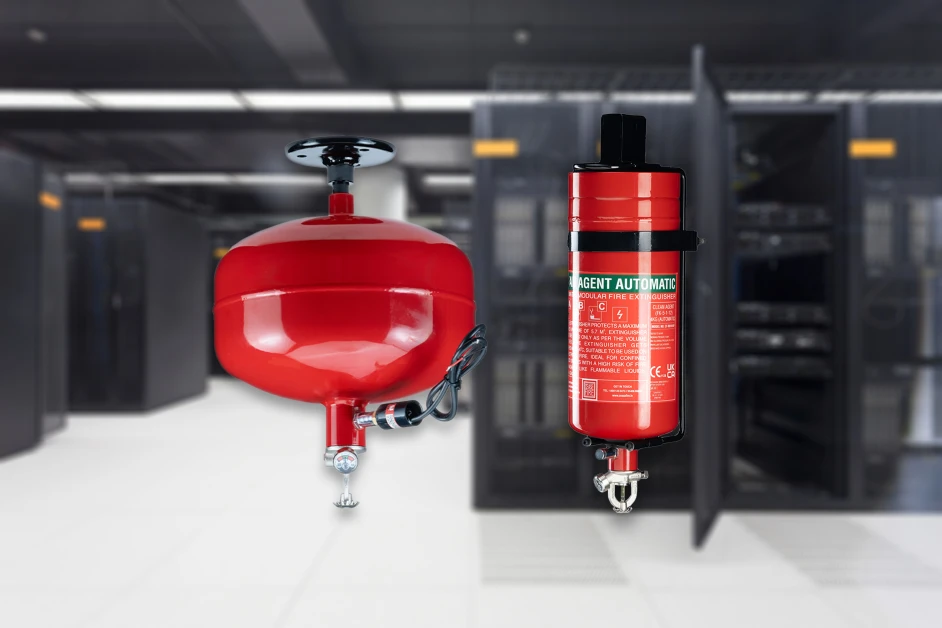
For many businesses, data and experience machinery are critical assets. Safeguarding infrastructure has become paramount. Traditionally, unmanned locations, such as server rooms have been protected by either sprinkler systems or large and bulky fire suppression units. However, there are now newer methods of protecting assets that are easier to fit and can help extinguish fires quickly.
Automatic fire extinguishers are essential in ensuring fire safety, particularly in server rooms and industrial settings that prioritise data protection. These sophisticated systems detect and extinguish fires at their inception, providing a proactive approach to minimise damage and business disruption. With various types available, each suited to different fire hazards and environments, selecting the right automatic fire extinguishers requires understanding their functionalities and benefits.
Automatic fire extinguishers are engineered to respond to fire threats swiftly and efficiently. These devices work by detecting temperature fluctuations that indicate the presence of fire. Typically, they are equipped with a heat-sensitive bulb, known as a Quartzoid Bulb Detector (QBD). If in the presence of extreme heat, the QBD breaks and the extinguishing agent is released. These heat-sensitive bulbs are available at various temperature thresholds, allowing for customisation based on the specific requirements of the environment and potential fire hazards.
Upon activation, the extinguisher releases a suppression agent such as dry powder, foam, or gas, depending on the type of fire hazard identified. The agent rapidly fills the area, smothering the flames and reducing the oxygen level to prevent re-ignition. This automatic process is crucial in environments like server rooms and other unmanned areas where human intervention might not be immediate. By operating independently, automatic extinguishers mitigate potential damage and ensure that fires are controlled before escalating, safeguarding equipment and minimising operational downtime.
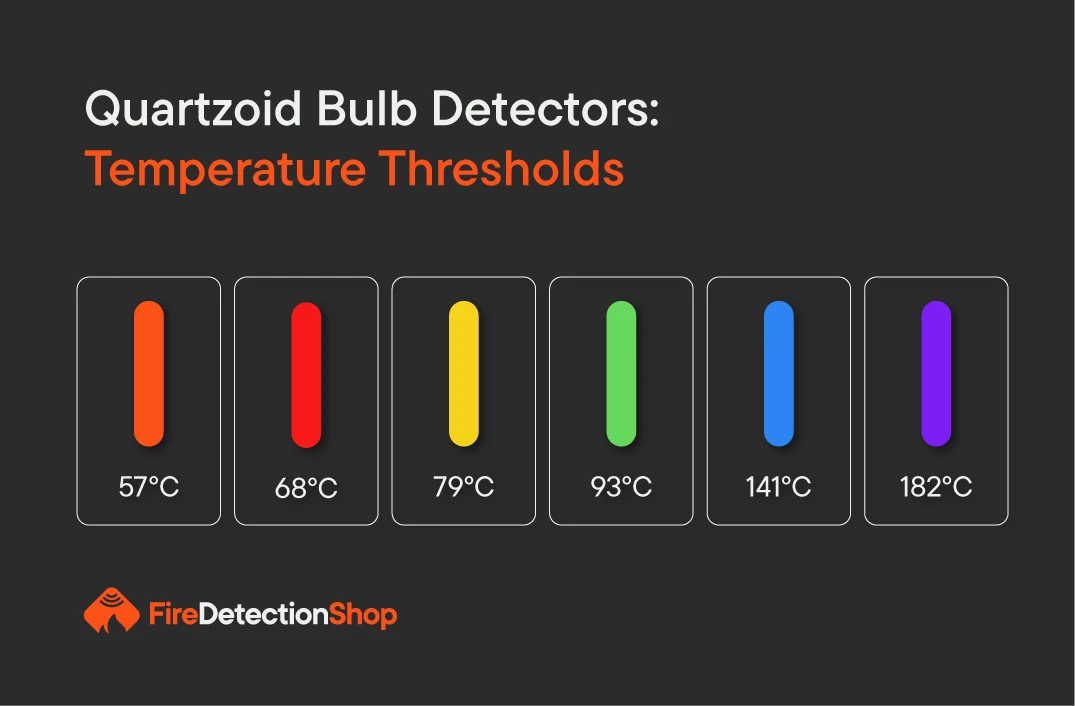
Automatic fire extinguishers offer several advantages for businesses, enhancing safety and operational continuity. Firstly, they provide real-time fire detection and suppression, significantly reducing the risk of extensive damage to vital infrastructure and assets. This is particularly beneficial in server rooms and industrial settings, where equipment is both expensive and critical to business operations. By minimising fire damage, businesses can avoid costly repairs and replacements, preserving their financial resources.
Additionally, automatic systems operate without human intervention, ensuring that fires are addressed even during off-hours or in unattended areas. This capability is crucial in preventing downtime and maintaining productivity. Furthermore, these systems contribute to compliance with UK fire safety regulations, potentially lowering insurance premiums and enhancing a business’s reputation for safety. Overall, investing in automatic fire extinguishers not only safeguards physical assets but also supports business resilience and continuity planning.
Automatic fire extinguishers come in various configurations to address different fire hazards efficiently. Common setups include tube-based, ceiling-mounted, and wall-mounted systems.
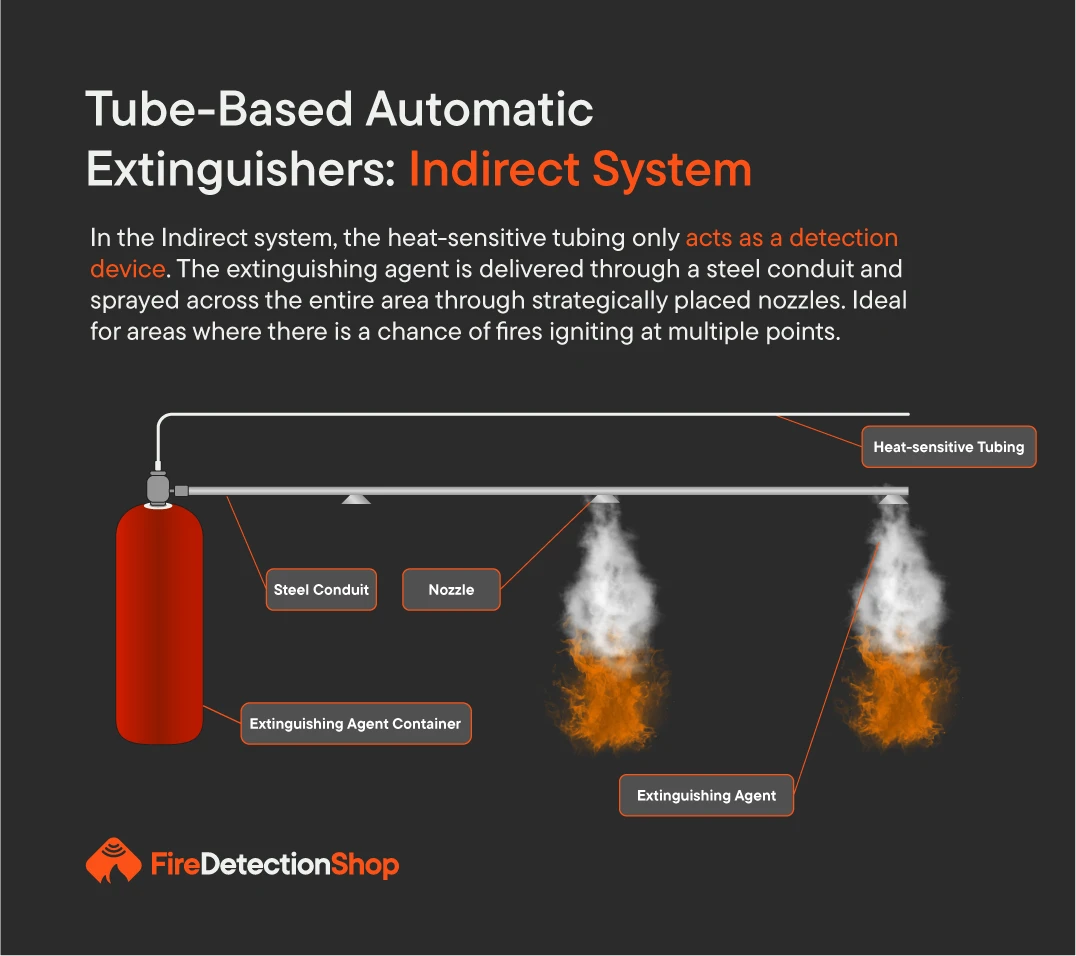
Tube-based extinguishers are compact and can be installed directly within machinery or equipment, allowing for immediate response to fire. Tube-based systems can come in various forms. One of which is a direct system where in the presence of heat the tube breaks where the fire is located. This releases the extinguishant directly onto the fire. An indirect system uses a tube to detect a fire but requires additional fitting of a steel conduit which releases the extinguishant. This form of tube-based fire suppression is great for suppressing a fire in a large area. A direct system isn’t as complicated to install however it only covers the area directly under the release of the extinguishant.
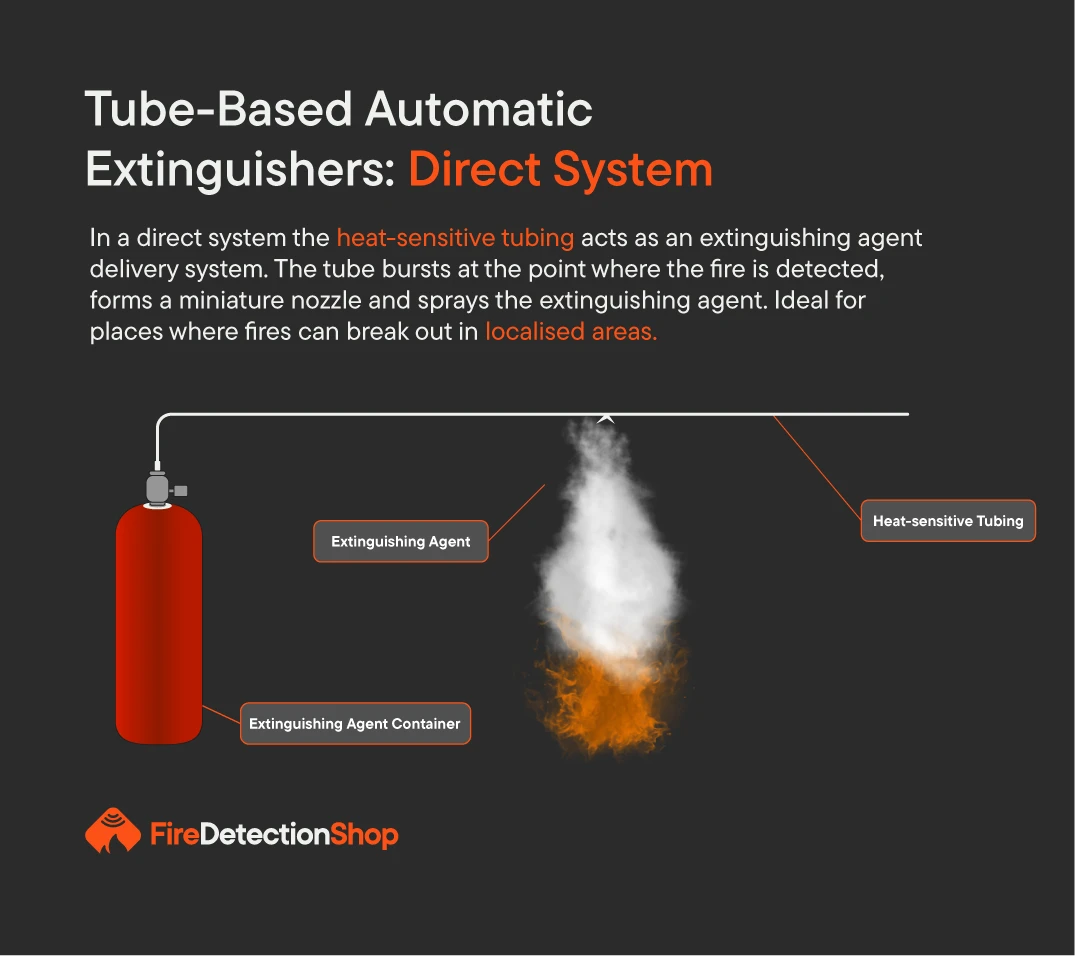
Ceiling-mounted automatic fire extinguishers provide widespread coverage in large areas, making them ideal for open spaces and facilities where floor access is limited. Wall-mounted extinguishers are positioned along walls for easy accessibility and are suitable for corridors and exit routes. Wall-mounted extinguishers are suitable for where a ceiling-mounted automated extinguisher wouldn’t be applicable, such as on a drop ceiling or an extremely tall ceiling.
Automatic fire extinguishers are traditionally available in larger sizes, often from 2kg up to around 15kg, however as technology has advanced, smaller options are now available in formats as small as 200g. These compact fire extinguishers are ideal for small, sensitive environments like electrical cabinets, server racks, and control panels. They can be installed in various settings including residential properties, educational facilities, industrial spaces, and healthcare facilities, protecting critical infrastructure and equipment from fire risks. They can either be inserted within a fire risk, such as a power supply unit, or installed externally with a tube that feeds into the unit.

Regarding the types of extinguishing agents, these systems typically use dry powder, foam, or gas-based agents. Dry powder is highly versatile and effective against flammable gases and electrical fires. Foam agents are designed for liquid fires, creating a barrier that prevents re-ignition, making them suitable for places with oil or petrol. Gas-based agents, such as carbon dioxide or clean agents like fluoroketone (FK), are effective in enclosed environments like server rooms. They extinguish fires by displacing oxygen, which prevents damage to sensitive equipment. Choosing the right configuration and extinguishing agent depends on the specific fire risks of the environment. Understanding these options ensures businesses adopt an effective fire safety strategy while meeting regulatory requirements.
Server rooms and data centres are critical components of modern businesses, housing valuable data and essential IT infrastructure. Protecting these environments from fire is crucial, as even minor incidents can result in significant data loss and operational downtime. Automatic fire extinguishers play a vital role in safeguarding server rooms by providing rapid fire detection and suppression.
Gas-based extinguishers, such as those using FK or inert gases, are particularly effective in these settings. They extinguish fires without leaving harmful residues that could damage sensitive equipment. Additionally, these systems operate automatically, ensuring swift response even during unmanned periods. Installing fire suppression systems designed specifically for server rooms helps mitigate the risk of fire-related damage. Regular maintenance and testing of these systems further enhance their reliability. By prioritising fire safety in server rooms and data centres, businesses can protect their critical assets, maintain operational continuity, and uphold the integrity of their data.
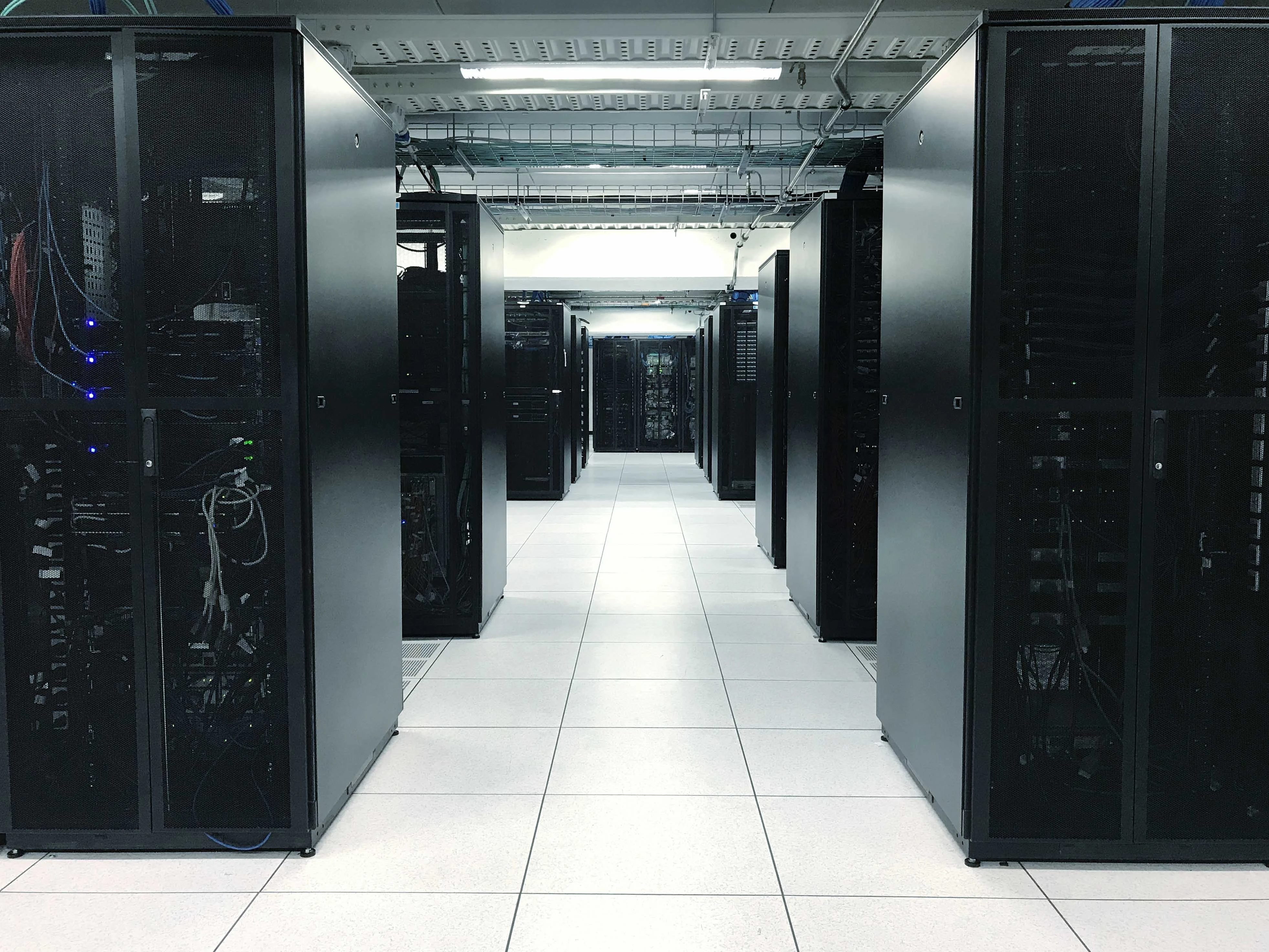
Industrial machinery often operates in high-risk environments where flammable materials and heavy-duty processes are common, making them susceptible to fire hazards. Automatic fire extinguishers are essential in protecting these valuable assets, as they provide immediate detection and suppression of fires, reducing the risk of extensive damage. Dry powder extinguishers are particularly effective for industrial settings due to their versatility in tackling various fire classes, including those involving flammable gases, liquids, and electrical equipment. Installing these systems directly onto machinery ensures quick activation, minimising downtime and preventing costly repairs or replacements. However, a fire risk assessment can help you identify risks and from this report, the correct extinguishant can be selected.
Furthermore, integrating automatic extinguishers into the machinery's operational framework allows for seamless fire safety management. Regular inspections and maintenance of the machinery and the extinguishing systems are crucial to maintaining optimal performance and compliance with industry regulations. By implementing robust fire safety measures, businesses can safeguard their industrial machinery, ensure worker safety, and maintain continuous production operations.
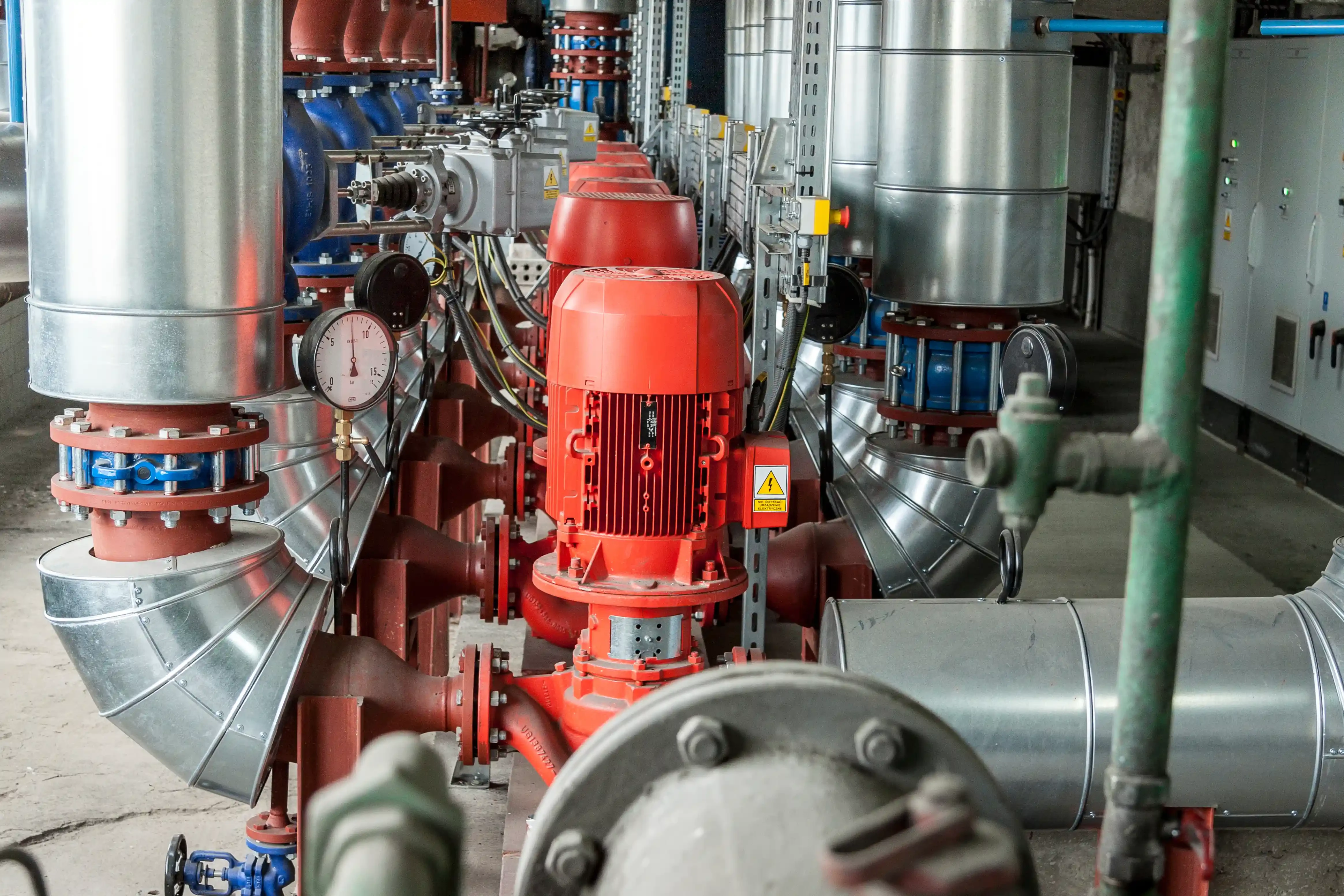
Enclosed spaces, such as storage rooms, electrical cabinets, and underground facilities, pose unique fire safety challenges due to limited access and ventilation. In these environments, automatic fire extinguishers are vital for ensuring rapid fire suppression, as they can operate effectively in confined areas without needing human intervention.
Gas-based extinguishers, such as FK clean agents, are especially suitable for enclosed spaces as they displace oxygen to extinguish fires without leaving residue, thus preventing damage to stored materials or equipment. The compact design of these systems allows for easy installation even in tight spaces, ensuring comprehensive coverage. Regular maintenance and testing are imperative to ascertain their readiness and effectiveness. Implementing automatic fire extinguishers in enclosed spaces enhances safety by addressing potential fire risks promptly, preventing escalation, and safeguarding assets and personnel. Additionally, these systems align with industry safety standards, ensuring compliance and peace of mind for businesses operating in such environments.
The incorporation of automatic fire extinguishers in server rooms and industrial settings represents an indispensable element of modern fire safety strategies. Their ability to swiftly detect and suppress fires minimises potential damage, safeguards critical data, and ensures business continuity.
By understanding the different types of automatic extinguishers available and tailoring them to specific environments, businesses can effectively reduce and control fire risks. Moreover, adherence to UK fire safety regulations not only ensures compliance but also enhances overall risk management. As technological advancements continue to evolve, investing in automatic fire extinguishers remains a proactive measure that supports both operational resilience and asset protection in diverse industrial landscapes.
05/03/2025 • by Alice P